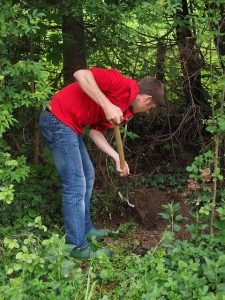I love using Anki to create the flash cards and then use them to easily memorise Spanish Vocabulary. They are really helping me learn loads of words extremely quickly.
It is very powerful to experience recalling the meaning of a word. Equally, it is just as powerful seeing a picture on a flashcard, and then being able to recall what the word was for that picture.
What is also tremendously satisfying is when you need to lean on the mnemonic imagery you have created in order to recall the translation.
So this morning I was presented with a picture of a pig on my flashcard.
Technically speaking, this is a picture of a piglet but I can refine my vocabulary to include that later. In fact I can do that now….
[A quick check on google translate and it is el cerdito. That will now go into Anki later on!]
Back to my pig story….
Faced with the image of the pig, I couldn’t remember the word outright. But I could remember the imagery I had created to help embed it into my subconscious.
So I worked backwards and started with the imagery.
I could see a scene in my imagination with my friend Sarah in her kitchen, kneading dough into the shape of a pig.
That is the imagery.
How do I then translate that back into the word for “pig”.
Well the word “Sarah” reminds me of the syllable “CER-“.
And “dough” reminds me of the syllable “-DO”.
So the word is “CERDO”.
Here’s How It Is Done
There is an interesting sequencing issue going on here.
The imagery was created with the starting point being the word CERDO.
When I broke it down phonetically it became CER – DO. This breakdown reminded me of ‘Sarah: and “Dough”. I could then make meaningful imagery from those because they are more meaningful concepts for me.
Whilst they have no bearing on what the actual word CERDO means, they are very closely related phonetically.
Presented in this way, the imagery leads it’s way to an image of a pig (it’s what Sarah is creating with the dough).
But I could have started from the concept of pig and then create imagery that ended up with Sarah doing something to a blob of dough. (I don’t know what the collective known for dough is… is it blob? Chunk? Dollop? Handful?).
Perhaps seeing a squealing pig jump into Sarah’s (CER-) arms. She then topples back onto a huge piece/blob/dollop of dough (-DO) the size of a double bed.
So the first approach is sequenced like this:
SPANISH WORD —> PHONETIC BASED IMAGERY —> ENGLISH TRANSLATION.
The second approach is sequenced like this
ENGLISH WORD —>PHONETIC BASED IMAGERY –> SPANISH TRANSLATION
It doesn’t matter which way you do it as long as the link is strong between the imagery you create and what the word means.
My preference is the first approach because when I encounter a Spanish word I don’t know it will trigger the association straight away.
Well that’s the theory anyway. As practiced as I am at creating mnemonic imagery, there are still times when I don’t make the connection strong enough. I have a beautiful image for the word. I just don’t know what it means.
When this happens I just go back and strengthen the link.
Here’s Another Example Of Imagery Helping Recall
 Similarly I was faced with a picture of someone digging and I couldn’t remember the word straight away.
Similarly I was faced with a picture of someone digging and I couldn’t remember the word straight away.
But I could remember the imagery (because we think in pictures) and from that I could deduce the word.
That is the secret.
So I had to pull out from my memory an image relating to something digging.
And so this time in my imagination, I could see a black London taxi cab holding a big letter R (yes in my picture the vehicle has grown a set of arms!) transforming into a digging machine.
So what I have got is a CAB and a letter R (pronounced AR like a pirate…. or farmer).
Put those together and (phonetically) you get CAB-AR.
The word to dig is Spanish is CAVAR (the V is pronounced like a B).
I keep pinching myself every time I experience the easy recall of a word like this.
When I compare it to trying to learn a word without it, they are worlds apart in effectiveness of recall.
Some people often say it takes far too long for them to create the imagery and they’d rather just grind the link in by repetition.
In the short term that is fine. But there are two problems with this:
Problem 1 – doing it like that relies on short term working memory. This has a finite capacity (would you believe only between 5-7 pieces of information!). That means once you have reached about 5 words, for every new word you try and learn, one you have already learnt gets pushed out of your short term memory. Which is why it is so easy to forget stuff you thought you knew well.
Problem 2 – Even if you just kept the number of words down to the limit of your short term memory (5-7 words), you will only recall it for a short period of time. You will effectively have to work through them again.
Using Mnemonic Imagery Makes Your Memories Last LONGER!
I don’t know the neuroscience behind it, but for some reason when you use mnemonic imagery (all that weird imagination shit!) a couple of amazing things happen:
Amazing Thing #1 – the images you create last much, much longer than simply trying to brute force an association between a Spanish Word and its translation. Somehow the process of making these images automatically transfers the words to longer term memory. Only this morning I tried to recall a word I learnt over 5 weeks ago. It took a bit of coaxing, but it came back. Wow! was my reaction. It’s a beautiful thing!
Amazing Thing #2 – You will be able to learn LOADS more words doing it this way. There is no reason why you can’t learn 200 plus words a day doing this! That’s a working vocabulary in 5 days! The only thing that is the limiting factor here is that it can be tiring because you do have to think.
Amazing Thing #3 – The more you do it, the better you become at it, the less time it will take, the more you will learn. And once you get faith and confidence in you being able to do it (you can!), you will never go back.
Amazing Thing #4 – It makes learning vocabulary, fun, enjoyable, stimulating and immensely satisfying.
Mnemonic Imagery Is Just A Crutch
Now of course the mnemonic imagery is merely a crutch.
It is there to give you a helping hand in the early days.
A boost to get the word into longer term memory where it is easier to access.
Using it is like strapping booster rockets to help drive the word into the orbit space of your long term memory, pushing it through the atmosphere of short term memory.
Just like booster rockets, the imagery will eventually drop away because eventually you will just “KNOW” the word and what it means.
I now know that “cerdo” means pig (or pork) through the imagery that I have created.
As time goes on I will need the imagery less and less. It will just fade. I will no longer need that crutch any more.
This is happening with quite a few words now that I “just know”. The imagery required to get it to that stage has been forgotten now it is no longer required.
…It’s a beautiful thing.








Leave A Response